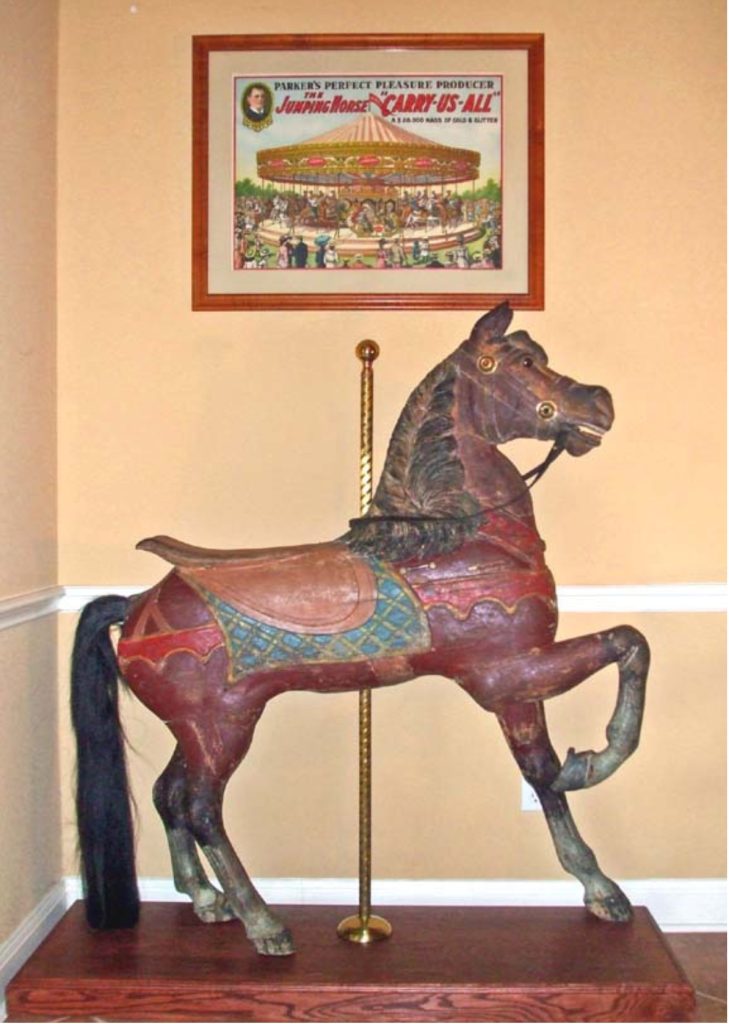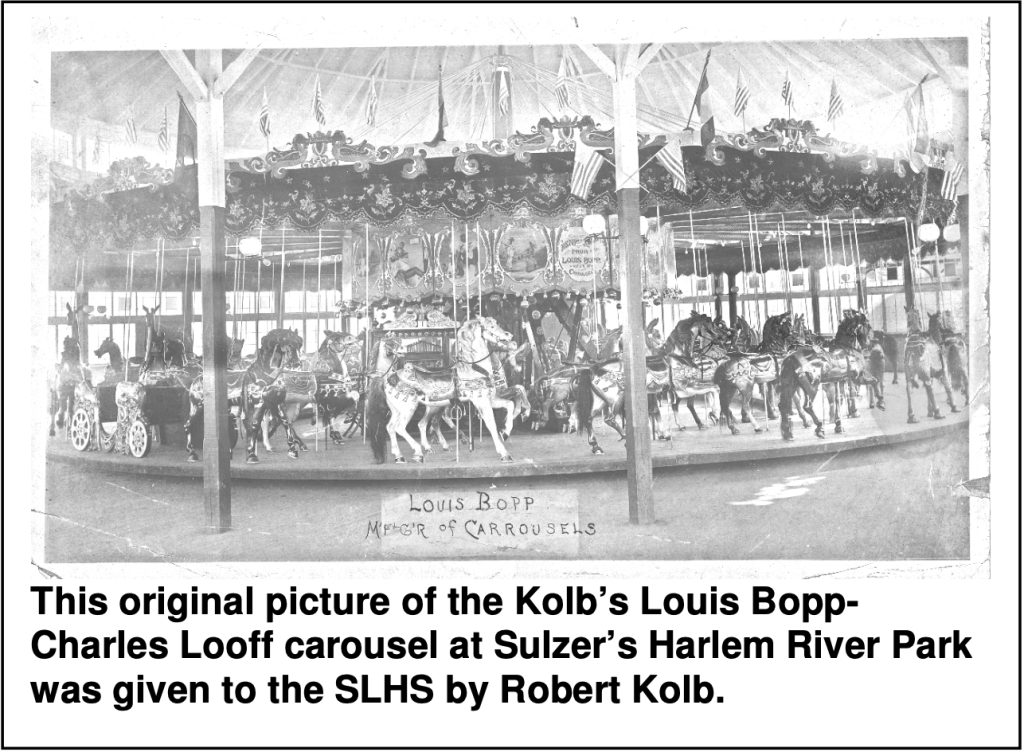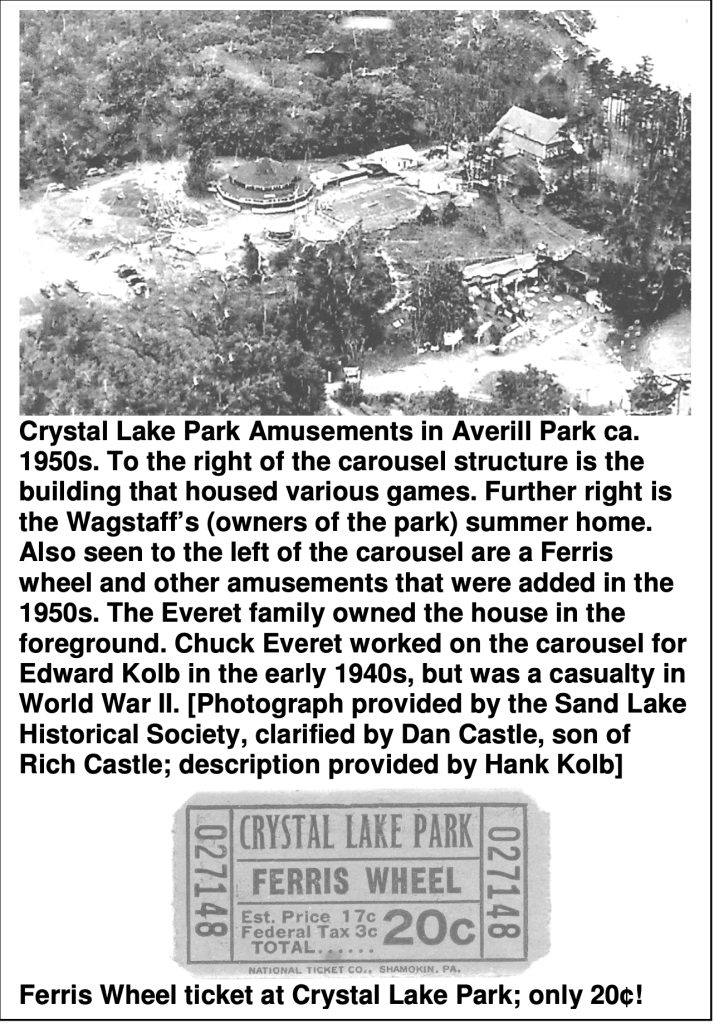“Meet Mascot at the Sand Lake Town Hall“
A presentation by SLHS member Rich Castle, talking about his experience as a young man in the 1950s working on the Crystal Lake Carousel.
Did you ride “Mascot” on the Carousel at Crystal Lake Park?
from SLHS “Historical Highlights HH36-1” courtesy of Andy Mace
William (Bill) Benjamin emailed the Sand Lake Historical Society’s web site for information on the carousel at Crystal Lake Park. Pictures printed from Charles Viens’ negatives were shared with him. Continued correspondence kept us in the loop until the article “History of Mascot on the 19th Century Louis Bopp–Charles Looff Carousel” was published in the June 2009 issue of The Carousel News and Trader. We have Bill’s permission to share his excellent history of the carousel from the late 1890s until 1978 in this issue of Historical Highlights and have indicated those quoted sections with some minor changes. And however big a thank you we can extend to you, Bill, it is humbly and gratefully given.

Bill Benjamin had obtained “Mascot, an early Looff Stander.” Was this merry-go-round horse, which had been severely charred in a house fire, one of those many hand- carved pieces made by Charles Looff? With utmost care and patience Bill removed Mascot’s burned exterior and coats of paint down to his original beautiful coat. Now came many questions. How old was Mascot? Who did make him? When and where did Mascot receive riders?
The article in the September/October 1999 issue of Reminisce by Robert Kolb, whose grandfather Edward Henry Kolb owned and operated the carousel at Crystal Lake, had the picture of the Louis Bopp – Charles Looff Carousel. Bill found Mascot with his “distinctive whorl- like pattern mane. The presence of the 45-star flags dates the photograph to be as early as July 4, 1896.”
Mascot’s biography now began in earnest. Robert Kolb’s brother, Henry (Hank), provided Bill with information that “the Louis Bopp-manufactured carousel began its life at Sulzer’s Harlem River Park, New York City. Following the refurbishing and conversion of the stationary carousel, to include jumpers on alternating 2nd and 3rd rows, the Kolbs relocated the carousel in 1908 to New Rensselaer Park in the Lansingburgh section of Troy.

Advertised as a monster carousel, it remained there until the park closed in 1920. Little information is known about the time the carousel was at Ford Park in Green Island ca. 1922 – 1926.”
“Robert Kolb has indicated that the carousel and the building were moved the 20 miles to Averill Park via the United Traction Company trolley line.” The Troy and New England Railway was “no longer providing public transportation so perhaps it was contracted with specifically to move the carousel.”
Bill continues with Mascot’s biography. “Hank and Robert Kolb have provided a wealth of history about the carousel at Crystal Lake Park. Crystal Lake was referred to as ‘the upstate Coney Island’; as a teenager Hank Kolb worked there at the carousel from the late 1930s to the mid- 1940s. Based on his account, Crystal Lake Park was owned by the Wagstaff family. His grandfather, Edward, rented the property and paid a portion of the ticket proceeds to Mr. Wagstaff.”
“Rides at Crystal Lake were 5 cents each or six for 25 cents. Hank would play two 78-rpm songs per ride on a Victrola record player. Hank admitted that he would often give ‘pretty young girls’ free rides. In the mid-1940s, ticket prices were raised to 8 cents. The carousel had a total of 58 figures and two chariots at this time. Like his father before him, Edward Kolb had names for many of the horses. The names were usually painted in small block letters, which also explains the continuation for Mascot’s name for an extended number of years.”
“ ‘Kitty’ and ‘Five Star’ were the names for two of the horses according to the Kolbs. Edward often painted the saddles red, which accounts for the remnants of red paint discovered on Mascot’s saddle during conservation.”
“According to Hank the carousel had a ‘Ring Game’, an arm filled with rings and an occasional brass ring. Riders on the outer figures would pull out the rings and return them to a bushel basket. The rider that pulled the brass ring would win a free ride. Hank recalls picking up many rings that missed the basket.”
“Hank Kolb relates that Crystal Lake Park had a number of entertainment attractions during the 1940s. One building housed a variety of games, including a ring toss and a milk bottle game. An ice cream parlor and a dance hall that opened on Saturday nights for round and square dancing were also present. A hot dog stand and restaurant were adjacent to the bathing beach. Many church, fireman and Odd Fellows picnics and clambakes were held at the park. The amusement park did well financially until 1941.
As with so many parks, once World War II began, business decreased considerably. Robert recalls that in 1945, shortly after the war, Edward Kolb decided to sell the carousel to Steve Krause for $3,500.”
“Rich Castle of Waterford, NY, age 69, worked for Steve Krause at Crystal Lake Park in the 1950s. Rich recalls that there was a Wurlitzer band organ at the carousel that was broken at the time. According to Steve Krause, Jr. a son of the last owner, during his time, the music was provided by 78-rpm records and then 45s. Krause kept the central housing panel paintings as well as the Henry Kolb/Louis Bopp sign and the building’s stained glass windows were intact. Two spare horses were kept in a shed to replace any that were broken during use.”
“The Kolb/Bopp carousel remained at Crystal Lake Park until 1960 when according to The Troy Record article, it was moved by U-Haul truck to Crescent, 20 miles northwest of Averill Park”.

“At Halfmoon Beach the distinctive stained glass windows were no longer present and were replaced with colored Plexiglas. By this time the price of a ride on the carousel had increased to 25 cents, and many of the animals’ saddles had been painted white.” “According to Robert Kolb, who visited the carousel in the 1960s, Krause had painted some of the figures in ‘loud chartreuse colors’”.
“The availability of the series of interior photographs has allowed us to identify all 58 figures on the carousel — 39 horses, 5 goats, 3 camels, 3 giraffes, 3 lions, 3 elephants and 2 teddy bears — plus two chariots, and to place them in configuration on the 50-ft., 20-section platform.”
“The carousel at Halfmoon Beach stopped serving patrons by 1976 and was bought by Gray Tuttle in 1978. Gray sold the figures to various collectors. However, considering that this “carousel treasure” had a working lifespan of more than 75 years and was likely enjoyed by several million patrons, it had a very successful existence. It certainly continues to live in many people’s memories and family experiences.”
Do you have any memories of the carousel at Crystal Lake Park? If so, we encourage you to get in touch with us at info@slhstrustees.org. Or please write us. This is how history is preserved. A copy of William Benjamin’s article is available in the Historical Society’s reference section at the Sand Lake Town Library and in the Town Historian’s office.

Leave a Reply